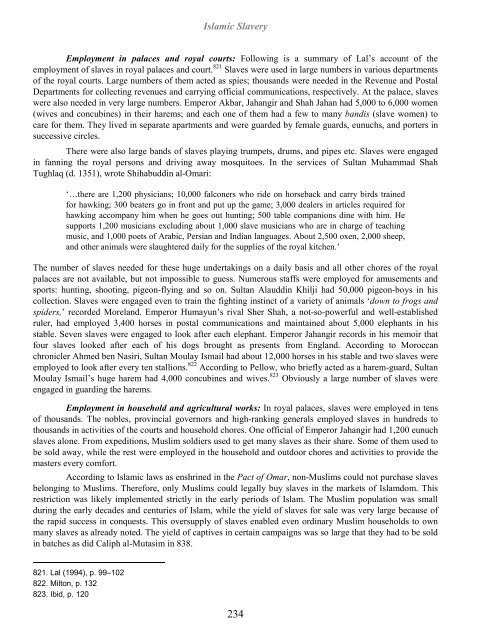islamic-jihad-legacy-of-forced-conversion-imperialism-slavery
islamic-jihad-legacy-of-forced-conversion-imperialism-slavery
islamic-jihad-legacy-of-forced-conversion-imperialism-slavery
- No tags were found...
You also want an ePaper? Increase the reach of your titles
YUMPU automatically turns print PDFs into web optimized ePapers that Google loves.
Islamic SlaveryEmployment in palaces and royal courts: Following is a summary <strong>of</strong> Lal’s account <strong>of</strong> theemployment <strong>of</strong> slaves in royal palaces and court. 821 Slaves were used in large numbers in various departments<strong>of</strong> the royal courts. Large numbers <strong>of</strong> them acted as spies; thousands were needed in the Revenue and PostalDepartments for collecting revenues and carrying <strong>of</strong>ficial communications, respectively. At the palace, slaveswere also needed in very large numbers. Emperor Akbar, Jahangir and Shah Jahan had 5,000 to 6,000 women(wives and concubines) in their harems; and each one <strong>of</strong> them had a few to many bandis (slave women) tocare for them. They lived in separate apartments and were guarded by female guards, eunuchs, and porters insuccessive circles.There were also large bands <strong>of</strong> slaves playing trumpets, drums, and pipes etc. Slaves were engagedin fanning the royal persons and driving away mosquitoes. In the services <strong>of</strong> Sultan Muhammad ShahTughlaq (d. 1351), wrote Shihabuddin al-Omari:‘…there are 1,200 physicians; 10,000 falconers who ride on horseback and carry birds trainedfor hawking; 300 beaters go in front and put up the game; 3,000 dealers in articles required forhawking accompany him when he goes out hunting; 500 table companions dine with him. Hesupports 1,200 musicians excluding about 1,000 slave musicians who are in charge <strong>of</strong> teachingmusic, and 1,000 poets <strong>of</strong> Arabic, Persian and Indian languages. About 2,500 oxen, 2,000 sheep,and other animals were slaughtered daily for the supplies <strong>of</strong> the royal kitchen.’The number <strong>of</strong> slaves needed for these huge undertakings on a daily basis and all other chores <strong>of</strong> the royalpalaces are not available, but not impossible to guess. Numerous staffs were employed for amusements andsports: hunting, shooting, pigeon-flying and so on. Sultan Alauddin Khilji had 50,000 pigeon-boys in hiscollection. Slaves were engaged even to train the fighting instinct <strong>of</strong> a variety <strong>of</strong> animals ‘down to frogs andspiders,’ recorded Moreland. Emperor Humayun’s rival Sher Shah, a not-so-powerful and well-establishedruler, had employed 3,400 horses in postal communications and maintained about 5,000 elephants in hisstable. Seven slaves were engaged to look after each elephant. Emperor Jahangir records in his memoir thatfour slaves looked after each <strong>of</strong> his dogs brought as presents from England. According to Moroccanchronicler Ahmed ben Nasiri, Sultan Moulay Ismail had about 12,000 horses in his stable and two slaves wereemployed to look after every ten stallions. 822 According to Pellow, who briefly acted as a harem-guard, SultanMoulay Ismail’s huge harem had 4,000 concubines and wives. 823 Obviously a large number <strong>of</strong> slaves wereengaged in guarding the harems.Employment in household and agricultural works: In royal palaces, slaves were employed in tens<strong>of</strong> thousands. The nobles, provincial governors and high-ranking generals employed slaves in hundreds tothousands in activities <strong>of</strong> the courts and household chores. One <strong>of</strong>ficial <strong>of</strong> Emperor Jahangir had 1,200 eunuchslaves alone. From expeditions, Muslim soldiers used to get many slaves as their share. Some <strong>of</strong> them used tobe sold away, while the rest were employed in the household and outdoor chores and activities to provide themasters every comfort.According to Islamic laws as enshrined in the Pact <strong>of</strong> Omar, non-Muslims could not purchase slavesbelonging to Muslims. Therefore, only Muslims could legally buy slaves in the markets <strong>of</strong> Islamdom. Thisrestriction was likely implemented strictly in the early periods <strong>of</strong> Islam. The Muslim population was smallduring the early decades and centuries <strong>of</strong> Islam, while the yield <strong>of</strong> slaves for sale was very large because <strong>of</strong>the rapid success in conquests. This oversupply <strong>of</strong> slaves enabled even ordinary Muslim households to ownmany slaves as already noted. The yield <strong>of</strong> captives in certain campaigns was so large that they had to be soldin batches as did Caliph al-Mutasim in 838.821. Lal (1994), p. 99–102822. Milton, p. 132823. Ibid, p. 120234


